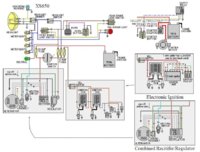timeconsuming
In Nonsense Is Strength
Hey guys
Here's a few notes on my bike to start with:
-1979 xs650
-PAMCO installed
-stock stator/alternator/reg-rec
-LED taillight
-single filament headlight
-xs performance coil
-stock size battery (12v 14ah?)
Anyway, I'm rewiring my bike (first time rewiring a bike from scratch) and trying to keep things simple but just want to get some opinions on what I've come up with.
Basically I tore the whole wiring harness out and went about simplifying as much as I could while still maintaining a few key functions (brake switches, tach light, etc).
I went off of this guy, as it had the same reg/rec-stator/alternator wires as my current (what I believe is stock) setup:

And then a simplified chopper setup with a PMA and a PAMCO:

I also used the diagram in my Haynes manual... and ended up with this as my design:

Any obvious flaws or recommendations for improvement?
Thanks!
Here's a few notes on my bike to start with:
-1979 xs650
-PAMCO installed
-stock stator/alternator/reg-rec
-LED taillight
-single filament headlight
-xs performance coil
-stock size battery (12v 14ah?)
Anyway, I'm rewiring my bike (first time rewiring a bike from scratch) and trying to keep things simple but just want to get some opinions on what I've come up with.
Basically I tore the whole wiring harness out and went about simplifying as much as I could while still maintaining a few key functions (brake switches, tach light, etc).
I went off of this guy, as it had the same reg/rec-stator/alternator wires as my current (what I believe is stock) setup:
And then a simplified chopper setup with a PMA and a PAMCO:

I also used the diagram in my Haynes manual... and ended up with this as my design:
Any obvious flaws or recommendations for improvement?
Thanks!



